From behind a glass porthole set into an altar covered in shells, a small dark creature stares out from the depths. It might be fierce or it might not be, this shadowy animal force. The creature sits alone in its cavern of shell. It holds something in its carved expression that once was human.
Getting that part right didn’t happen immediately, says artist Susanna Blunt of her sculpture Reliquary.
At first the creature in the porthole was too fragile. “It didn’t have enough of a presence,” she says.
“You can’t tell in your head if something’s going to work,” she says. “You have to see it with your eyes.”
In a glass case across from Reliquary in Blunt’s North Vancouver home are other sculptures, this time from her Skin, Bone & Soul series.
There are shapes cast from molds of cow horns, some smoked to darken them, gathered in a bunch so they resemble worms or anemones.
There’s another piece, Messenger, that looks like a crown above a pale mask or net, made of tusks, fur and woven leather goatskin. Translucent snakeskins hang on it, left behind.
On the shelf above, two voodoo dolls balance on either side of a skateboard, spinning as they leer diabolically in her piece Truth and Beauty #1. They’re humorous and more than a bit creepy. “I have a lot of things that are quite dark in mood but other things that are very playful,” says Blunt. “I really like the absurd.”
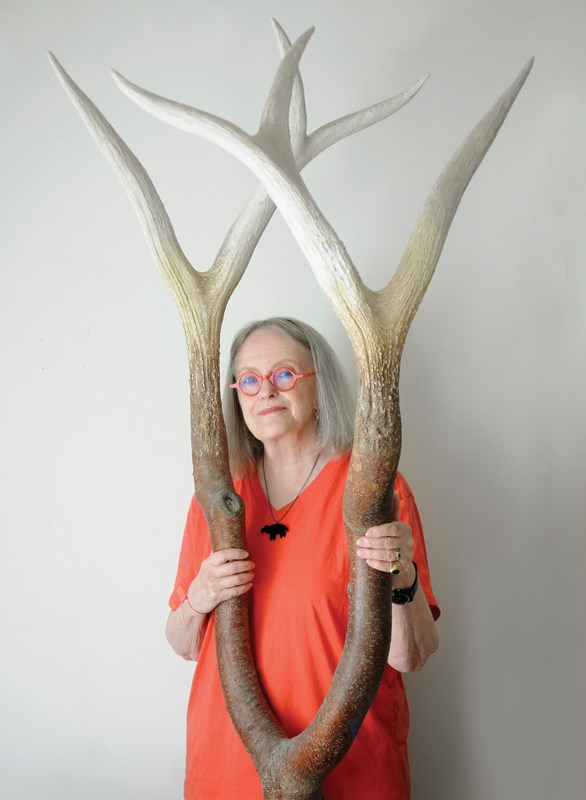
Blunt’s lifelong work as an artist has spanned many mediums – from painstakingly crafted portraits in oil and acrylics, to prints, collage and drawings in ink, charcoal and pencil to modern sculpture and installation pieces.
“She’s kind of an anthropologist of artifacts of contemporary cast-offs,” says George Rammell, a Vancouver sculptor, who taught Blunt at Capilano University’s now-shuttered Studio Art and Art Institute programs. “She re-arranges them in a manner that might make people feel uncomfortable.”
“Artists are explorers,” says Blunt.
When she’s working on a piece, “I’m always surprised,” she says. “If I’m not surprised, I feel I haven’t discovered something well enough.”
Blunt has had a long career as an artist, and has studied and taught art in places ranging from Marin County, Calif., to the University of British Columbia and exhibited in both group and solo shows around the world.
As a young art student she once worked for Yoko Ono and studied at the prestigious Royal Academy of Art in London, England, which chose one of her sculptures as part of its summer exhibition in 2016.
Blunt has a wide circle of friends in the world of art and culture. Admirers of her work include people like the British sculptor David Mach who declared Blunt’s art “fucking brilliant,” according to friends.
She also hosts regular discussion groups on art at her home. “You never know who’s going to show up,” says Rammell, who’s encountered the likes of filmmaker Nettie Wild, playwright John Gray and artist Arnold Shives at Blunt’s gatherings. “She really is like the Gertrude Stein of Vancouver,” says Rammell.
In the public eye, Blunt has flown largely under the radar.
While Blunt’s portraiture has garnered attention – we all carry a copy of her famous portrait of the Queen around in our wallets on the back of our Canadian coins – for the most part she doesn’t operate in the realm of well-known galleries, social media marketing or what Rammell refers to as “the art star scene.”
This fall, however, Blunt is being recognized – along with North Shore singer and actor Marcus Mosely – as one of two 2017 artists of distinction chosen by the Fund for the Arts on the North Shore. The annual award celebrates local artists who have national or international stature. She’ll be in good company. Recipients over the past two decades include Douglas Coupland, Bryan Adams, Anna Wyman and Nicola Cavendish to name just a few.
In person, Blunt peers out intensely from behind a pair of red-rimmed glasses, fluttering and swooping like a magpie on treasures she has collected in her studio – bits of metal, bones and feathers, an old piano key, a bronze cabinet knob in the shape of a duck’s head – with visible longing.
“Sculptors go mad when they look at materials. We prowl around,” she says.
Sometimes she begins to work with a vague idea. Other times she picks up an object and carries it around until it says something to her.
“I really think in materials now,” she says, the way a poet might be hooked on words or phrases.
“Objects interest me. In their shape. In their history.”
Blunts says she’s been a serious junk collector – digging around in the dirt of human cast-offs – for many years now.
“She has an extraordinary ability to look at a piece of industrial waste and see it for its transcendent qualities, its beauty and its metaphorical possibilities,” says friend and fellow sculptor Alexandra Phillips.
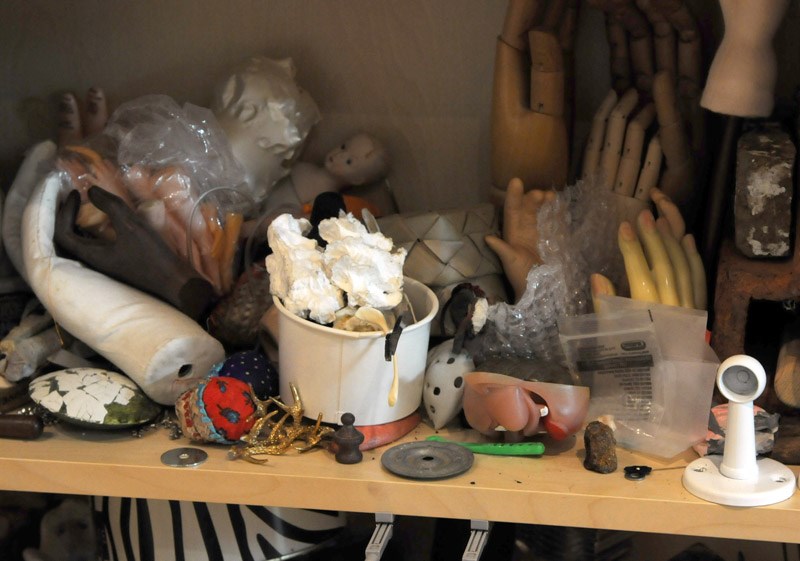
In what Blunt calls her “toy cupboard,” where she collects some of those objects, there are rusted tools, a doll’s head, a knot of primary-coloured rubber tubing.
There are bits of skulls and fossils, light fixtures, pieces of plastic, old cages, bottle brushes.
“It’s absolutely bulging with things I’m dying to work on,” she says.
She pulls out a dried, twisted wisteria seedpod, stroking the velvet underside.
“I think it’s so stunningly beautiful I can’t bear it,” she says.
Once her son gave her a birthday present of a session at a spa. “I never go to those places,” says Blunt. “(But) I had seen some horse teeth in a junk store that I wanted desperately and I asked him if he couldn’t get a refund and buy me the horse teeth instead. He was horrified.”
“The most fun you can have is to go to a flea market with Susanna Blunt,” says Phillips. “But take lots of cash.”
Blunt’s art is often witty, adds Phillips.
Take Tripping, for instance, Blunt’s ode to masculinity on steroids that she exhibited at the Royal Academy. She started with an old fashioned doll’s body. “I felt he needed a third leg,” says Blunt mischievously. And perhaps a boxing glove in a specimen jar where a brain should be.
“She has a very sly sense of humour that creeps into her work,” says Phillips. “There’s a certain cheekiness.”
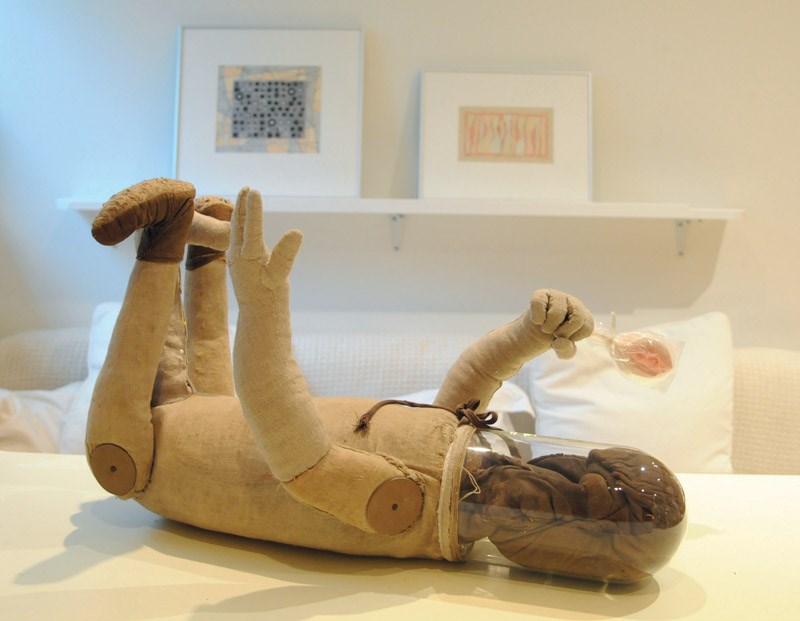
For her Totem series, Blunt took casts of everyday objects found in flea markets and arranged them in formal pillars that hint at stories and the lives behind their cool white columns. When objects are taken out of context like that “there’s a sense of nostalgia and recognition but we’re not really sure why,” she says.
“Who knows what lives they might have occupied at one point or another?” Were they hoarded or given as gifts or bought to show off for the neighbours?
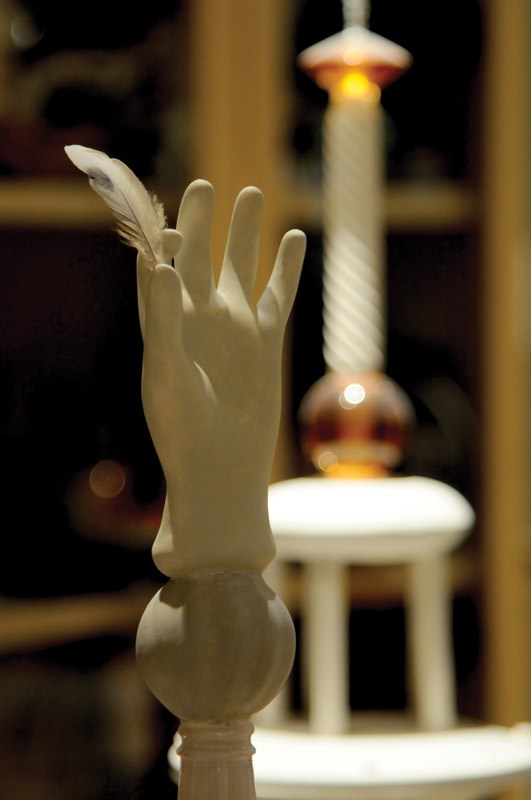
Blunt’s Dubai project came about after she was invited to an art fair by the renowned Iranian sculptor and part-time North Shore resident Parviz Tanavoli, an admirer of her work. While wandering around the city, Blunt came across junk on a work site and began to pick it up. “When I got the objects I just loved the strange shapes,” she says.
“I felt like an archeologist finding things before the city was built instead of several centuries later when it was lost and forgotten and rediscovered,” she said.
Blunt found the objects also saying something about the unnoticed lives of the workers who were building the city, “a glittering greedy” place of total artifice.
She created ink impressions of the objects and arranged them on paper like a musical score.
“It looks like beautiful calligraphy,” she says. “They are not dirty old things lying in the dirt. They are dancing marks that give off tremendous energy.”
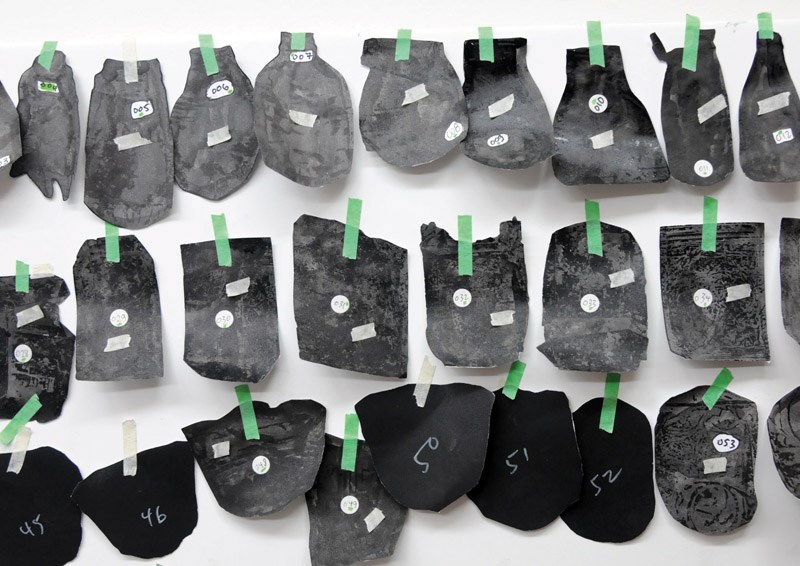
She tapped a similar vein in conjuring shadowy faces and mysterious flying creatures by arranging and overlapping images of her own x-rays, fingerprints and even mammograms.
When objects are out of context, she says, “Your thinking is automatically reorganized” and plugs into the unconscious.
“I feel that visceral response is the one I trust. I trust it a lot more than the brain,” she says. “What makes people cry when they listen to music? Are they performing an intellectual exercise? I don’t think so.”
In her sculpture The Alchemist, a torso rises from an industrial-shaped base, embellished with broken auto glass. In his hands the figure holds scientific pipettes in primary colours “for pouring chemicals and starting something,” says Blunt. Alchemy, and the desire to make gold out of baser materials, speaks to the human psyche, says Blunt.
“That’s what doctors are and that’s what scientists are and artists are,” she says.
But as an artist, she says, she is merely the conduit. “I feel like someone who’s learned to plug into a good source of electricity,” she says. “If I’m very, very lucky, things happen as a result of my finger in the socket.”
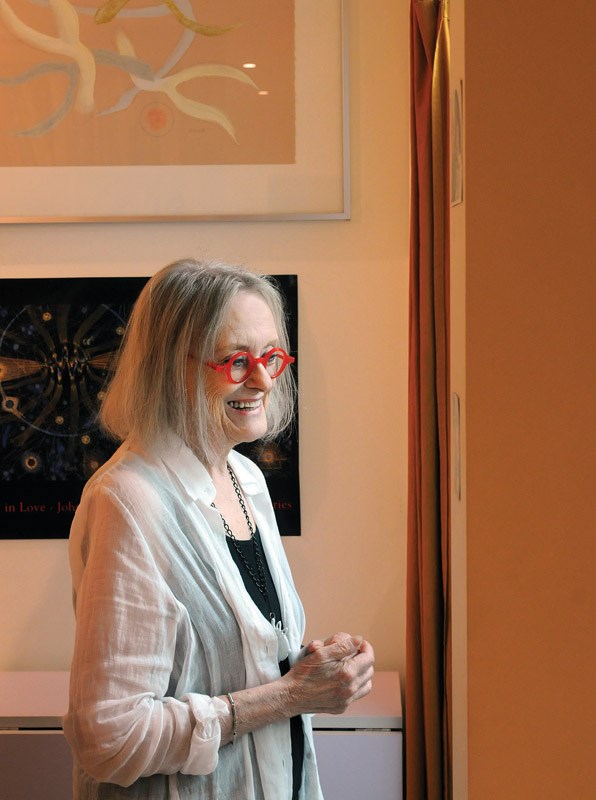
As part of Culture Days 2017, Blunt will be showcasing her interactive work Sept. 30 from 11 a.m. to 2 p.m. in the south plaza Lonsdale Quay, filming participants’ reactions for an accompanying film piece.



